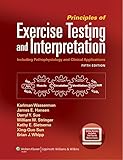Principles of exercise testing and interpretation :
Mention d'édition :5th ed. Publié par : Wolters Kluwer Health/Lippincott Williams & Wilkins, (Philadelphia :) Détails physiques : xiii, 572 pages : color illustrations ; 29 cm ISBN :9781609138998; 1609138996.| Type de document | Site actuel | Cote | Statut | Date de retour prévue | Code à barres | Réservations |
|---|---|---|---|---|---|---|
| Livre | La bibliothèque des Sciences Médicales et Pharmaceutiques | 616.120754 WAS (Parcourir l'étagère) | Disponible | 0000000025292 |
Includes bibliographical references and index.
Exercise testing and interpretation -- Physiology of exercise -- Changes in blood gases and pH during exercise -- Measurements during integrative cardiopulmonary exercise testing -- Pathophysiology of disorders limiting exercise -- Clinical exercise testing -- Normal values -- Diagnostic specificity of exercise intolerance: a flowchart approach -- Clinical applications of cardiopulmonary exercise testing -- Case presentations.
"In this fifth edition of Principles of Exercise Testing and Interpretation, as in earlier editions, we attempt to develop conceptual advances in the physiology and pathophysiology of exercise, particularly as related to the practice of medicine. The underlying theme of the book continues to be the recognition that the most important requirement for exercise performance is transport of oxygen to support the bioenergetic processes in the muscle cells (including, of course, the heart) and elimination of the carbon dioxide formed as a byproduct of exercise metabolism. Thus, appropriate cardiovascular and ven- tilatory responses are required to match those of muscle respiration in meeting the energy demands of exercise. As depicted by the logo on the book cover, normal exercise performance requires an efficient coupling of external to internal (cellular) respiration. Appropriate treatment of exercise intolerance requires that patients' symptoms be thought of in terms of a gas exchange defect between the cell and the environment. The defect may be in the lungs, heart, peripheral or pulmonary circulations, the muscles themselves, or there may be a combination of defects. Thus, we describe the pathophysiology in gas transport and exchange that affect any site in the cardio- respiratory coupling between the lungs and the muscles. We illustrate how cardiopulmonary exercise testing can provide the means for a critical evaluation by the clinician-scientist of the functional competency of each component in the coupling of cellular to external respiration, including the cardiovascular system. To achieve this, clinical cases are used to illustrate the wide spectrum of pathophysiology capable of causing exercise intolerance"--Provided by publisher.


Il n'y a pas de commentaire pour ce document.